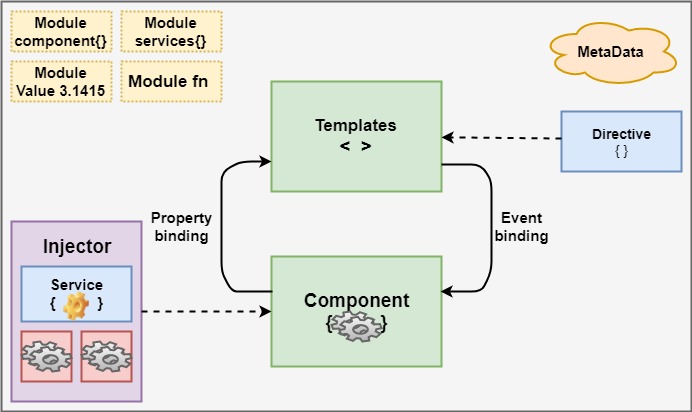Simply put a module is just a class just like components and services. The same goes for any other angular building block required by this module only.

Angular Module Tutorial Application Structure Using Modules
You can think of modules like packages or bundles containing the required code for a specific use case.

Angular component per module. In programming terms Modules can be described as the self-contained chunks of the functionality in. There are multiple ways to register a service in Angular. Deciding where to configure your provider and understanding the differences is key to under.
So we can think of that as the middleman between the browser and our application. Our modules are usually made up of multiple components services directives and pipes. AppComponent export class AppModule.
Import Component OnInit from angularcore. Angular modules are a way to consolidate features that belong together into discrete units. We can configure a provider on the NgModule on a components or directives providers property and on a components viewProviders property.
Keeping the size of the Angular Material library we add to our applications down to a minimum. We can configure the DI framework in Angular in three main ways. I consider one module per component the best way to design your Angular apps.
Now when using Angular Material we only import the module for the components we are using. We have also imported BrowserModule. The idea is to keep things close.
That module can contain components directives pipes services interfaces enums utils and so on. It may seem more work at first but it will pay you back will less maintenace problems. So its better to use feature modules and in that case you can split your features into multiple components if needed.
These can be 2 components and if table is the one which can be generalised and used in different modules then you can add table component to shared module. The code in angular is generally organized in modules. Many features of Angular itself are organized as Angular modules.
Lets start by defining a new component that we are going to use to show credit card information. HTTP services are in the HttpModule. The browser module is actually the ng module for our browser as per Angulars official documentation.
To create a component and register it in a module at the same time use the following Angular CLI command. Before an Angular service can be consumed it has to be registered with either an Angular module or an Angular component. The Modules are core of any Angular apps.
Import TranslateService from ngx-translatecore. The router is in the RouterModule. The most prominent Module is the App-Module because it comes with every new application generated by the cli.
In the previous tutorial on Angular Modules we learnt how to create the multiple feature modules in a application. If it depends on other components you can include only the component modules related to each component that is a direct dependency and dont need to care about indirect dependencies. And set the MyComponentModule in the imports in appmodulets like this view code below.
Our App will going to contain several such modules each implementing a specific feature. In this tutorial we will learn how to setup routing between multiple feature modules. So a pipe that is solely used in the Speakers module should not be defined in the global scope or inside Core.
For example if Sales section has a detail part and a table. This approach has been used to great effect by the Angular Material team who changed from the feature module approach to the component per module approach. How to load translations per module is described in the documentation.
It can also be used when generating directives. Import HttpClient from angularcommonhttp. Ng generate component productsproductItem --moduleproducts The --module flag indicates the module that the component is registered with in our case the products module.
Import MyComponentModule from yourfilepath. In this guide you will learn about the different ways to register an Angular service and consume it in other services and components. If you want to load on a component by component basis you can try something like this.
Registering components with a module. In this chapter we are going to extend the example we had before with a custom component pipe and service. In Angular Modules are the collection of the components services directives and Pipes which are related such that they can be combined to form a module.
Every component in our app needs to be declared inside an Angular module for us to use it. Export const EN_TRANSLATIONS.

Emulating Tree Shakable Components Using Single Component Angular Modules Dev Community

Ngmodule Providers Vs Component Providers Vs Component Viewproviders Angular

What S The Difference Between An Angular Component And Module Stack Overflow

Devcurry Testing Angular Component Using Jest

Angular 8 Architecture Tutorial And Example

How Angular Works How An Angular Application Works

Angular Understanding Modules And Services By Michele Stieven Medium

What S The Difference Between An Angular Component And Module Stack Overflow

Angular Architecture Components And Features

Introduction To Angular Modules Tektutorialshub

What S The Difference Between An Angular Component And Module Stack Overflow

Creating A Custom Ngmodule For Material Components In Angular By Armno P Medium

Angular Architecture Components And Features

Angular Architecture And Design Guidelines Thecodebuzz

What Are Components In Angular Interview Questions Angular Javascript Java Php Sql C Vue Nodejs Reactjs
Environment Specific Modules Services And Components In Angular Konrad Garus

Architecture Overview Ts Guide

Smarter Way To Organize Import Statements Using Index Ts File S In Angular By Balram Chavan Medium

Angular Architecture Components And Features

0 Comments